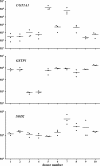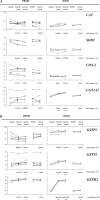Gene expression profiles in human peripheral blood mononuclear cells as biomarkers for nutritional in vitro and in vivo investigations
- PMID: 21189867
- PMCID: PMC2989368
- DOI: 10.1007/s12263-010-0170-1
Gene expression profiles in human peripheral blood mononuclear cells as biomarkers for nutritional in vitro and in vivo investigations
Abstract
Identification of chemopreventive substances may be achieved by measuring biological endpoints in human cells in vitro. Since generally only tumour cells are available for such investigations, our aim was to test the applicability of peripheral blood mononuclear cells (PBMC) as an in vitro primary cell model since they mimic the human in vivo situation and are relatively easily available. Cell culture conditions were refined, and the basal variation of gene expression related to drug metabolism and stress response was determined. Results were compared with profiles of an established human colon cell line (HT29) as standard. For biomarker development of nutritional effects, PBMC and HT29 cells were treated with potentially chemopreventive substances (chrysin and butyrate), and gene expression was determined. Key results were that relevant stress response genes, such as glutathione S-transferase T2 (GSTT2) and GSTM2, were modulated by butyrate in PBMC as in HT29 cells, but the blood cells were less sensitive and responded with high individual differences. We conclude that these cells may serve as a surrogate tissue in dietary investigations and the identified differentially expressed genes have the potential to become marker genes for population studies on biological effects.
Keywords: Biomarker; Butyrate; Gene expression; HT29 cells; Human peripheral blood mononuclear cells.
Figures



References
-
- Baez S, Segura-Aguilar J, Widersten M, Johansson AS, Mannervik B. Glutathione transferases catalyse the detoxication of oxidized metabolites (o-quinones) of catecholamines and may serve as an antioxidant system preventing degenerative cellular processes. Biochem J. 1997;324(Pt 1):25–28. - PMC - PubMed
-
- Bell DA, Taylor JA, Paulson DF, Robertson CN, Mohler JL, Lucier GW. Genetic risk and carcinogen exposure: a common inherited defect of the carcinogen-metabolism gene glutathione S-transferase M1 (GSTM1) that increases susceptibility to bladder cancer. J Natl Cancer Inst. 1993;85:1159–1164. doi: 10.1093/jnci/85.14.1159. - DOI - PubMed
-
- Bouwens M, Afman LA, Muller M. Fasting induces changes in peripheral blood mononuclear cell gene expression profiles related to increases in fatty acid beta-oxidation: functional role of peroxisome proliferator activated receptor alpha in human peripheral blood mononuclear cells. Am J Clin Nutr. 2007;86:1515–1523. - PubMed
LinkOut - more resources
Full Text Sources
Research Materials
